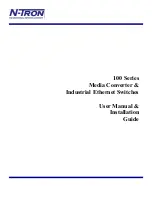
TP-6461 1/08
15
Section 1 Scheduled Maintenance
1.2.2
Internal Inspections and
Maintenance
Internal Inspection.
Have an authorized distributor/
dealer perform an annual inspection of the transfer
switch. Inspect the switch more frequently if it is located
in a dusty or dirty area or when any condition noticed
during an external inspection may have affected internal
components. Disconnect all power sources, open the
transfer
switch
enclosure,
and
inspect
internal
components. Look for:
D
Accumulations of dirt, dust, moisture, or other
contaminants
D
Signs of corrosion
D
Worn, missing, or broken components
D
Loose hardware
D
Wire or cable insulation deterioration, cuts, or
abrasions
D
Signs
of
overheating
or
loose
connections:
discoloration of metal, melted plastic, or a burning
odor
D
Other evidence of wear, damage, deterioration, or
malfunction of the transfer switch or its components
Cleaning.
Use a vacuum cleaner or a dry cloth or brush
to remove contaminants from internal components.
Do
not use compressed air to clean the switch because it
can cause debris to lodge in the components and
damage the switch.
Lubrication.
Maintain the transfer switch lubrication. If
the transfer switch is subject to extremely dusty or
abnormal
operating
conditions,
relubricate
all
movements and linkages yearly.
Relubricate the
solenoid operator if the TS coil is replaced. Do not use
oil; order the lubrication kit shown in the Parts Catalog.
Disconnect power and manually operate the transfer
switch mechanism to verify that it operates smoothly
without binding. If lubricating the outer mechanism of
the transfer switch does not eliminate binding, replace
the transfer switch assembly.
Periodically oil the enclosure door locks and screws.
Part Replacement and Tightening.
Replace worn,
missing, broken, deteriorated, or corroded internal
components
with
manufacturer-recommended
replacement parts.
Contact a local authorized
distributor/dealer for part information and part ordering.
Tighten loose internal hardware.
Terminal Tightening.
Loose connections on the
power circuits can lead to overheating or explosion.
Tighten all lugs to the torque values shown on the label
on the switch. Tighten engine start, input/output, and
auxiliary connections to the torque indicated on the
decals affixed to the unit.
Signs of Overheating.
Replace components damaged
by overheating and locate the cause of the overheating.
Overheating
could
be
caused
by
loose
power
connections, overloading, or a short circuit in system.
After tightening the power terminals, perform a millivolt
drop test to locate areas with high contact resistance.
See Section 1.3.3. Check the line circuit breakers in the
system to be sure that they do not allow the load to
exceed
the
switch
rating.
Use
the
controller
troubleshooting and schematics to locate a control
circuit short.
Wire Repair or Replacement.
Replace wiring when
there is any doubt about its condition or when there is
extensive damage or deterioration. If the damaged or
deteriorated wires are part of a wiring harness, replace
the entire wiring harness.
Power Circuit Wiring.
Have damage to line voltage
and power circuit wiring evaluated and repaired or
replaced by a qualified electrician.
Control Circuit Leads.
Repair minor damage to leads
in low power and control circuits operating up to
250 volts. Carefully splice and insulate the connections.
Tape minor control circuit wire insulation cuts or
abrasions. Repair moderately damaged leads, where
conductors are cut or insulation is damaged over
sections shorter than about 100 mm (4 in.) or less than
about 25% of the length of the wire, by cutting out the
damaged section and splicing in wire of the same type.
Use UL-listed insulated (250 V minimum) connectors
and follow the connector manufacturer’s instructions.
Fabricate new leads using the same type of wire and
UL-listed insulated (250 V minimum) connectors and
follow the connector manufacturer’s instructions.
Содержание KGP
Страница 2: ......
Страница 6: ...TP 6461 1 08 6 Notes ...
Страница 10: ...TP 6461 1 08 10 Safety Precautions and Instructions Notes ...
Страница 22: ...TP 6461 1 08 22 Section 1 Scheduled Maintenance Notes ...
Страница 36: ...TP 6461 1 08 36 Section 2 Controller Troubleshooting Notes ...
Страница 54: ...TP 6461 1 08 54 Section 3 Transfer Switch Troubleshooting Notes ...
Страница 78: ...TP 6461 1 08 78 Section 4 Controller Test and Replacement Notes ...
Страница 86: ...TP 6461 1 08 86 Section 5 Component Replacement Model KGS KGP Notes ...
Страница 100: ...TP 6461 1 08 100 Section 6 Component Replacement Model KSS Switches Notes ...
Страница 125: ......
















































